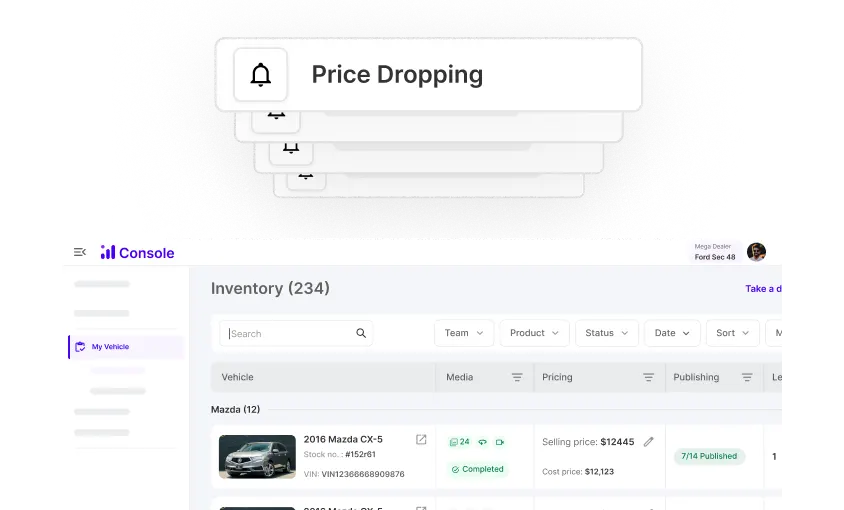%2Fhttps%3A%2F%2Fspyne-static.s3.us-east-1.amazonaws.com%2Fplugin-library%2Fretail-pages%2FheroBG2.png&w=3840&q=90)
AI-Powered Automotive
Inventory Management Software
From description to dashboard, Spyne handles every step of inventory management. Create listings, set the right price, and publish everywhere instantly. AI insights help you stock smarter and sell faster.
%2Fhttps%3A%2F%2Fspyne-static.s3.amazonaws.com%2Fplugin-library%2Fimages%2F2a5175dd-d306-4da7-a07d-027ddc2f6a78.webp&w=3840&q=90)
Trusted by teams at over 1,000 of the world's leading organizations
Dealership Inventory Management
What's Slowing Your Inventory Turnover?
Managing automotive inventory with outdated tools leads to missed opportunities and wasted time. Here are the key roadblocks slowing down dealerships today.
%2Fhttps%3A%2F%2Fspyne-static.s3.amazonaws.com%2Fplugin-library%2Fimages%2F4681e06f-9825-4663-9e6e-b05f0c78dba7.webp&w=828&q=75)
Manual Data Entry & Listing Fatigue
Time-consuming processes make your team less efficient and delay listings across channels.
Vehicle Management Software
Dealerships Using Spyne Sell Smarter and Faster
Inventory AI delivers measurable results for forward-thinking dealerships.
37%
Faster Inventory Turnover
Automated insights help dealerships identify and sell high-demand vehicles quicker.
22%
Increase in Lead Conversions
Professional listings and smart pricing boost buyer engagement and inquiry volume.
80%
Reduction in Manual Work
Automations free up your team from repetitive tasks—so they focus on closing.
Automotive Inventory Software
One Platform to Run Your Entire Lot — Try Now
From instant descriptions to one-click publishing and real-time pricing, everything you need to manage, market, and move your inventory effortlessly.
%2Fhttps%3A%2F%2Fspyne-static.s3.us-east-1.amazonaws.com%2Fplugin-library%2Fretail-pages%2FnewsletterBG.png&w=3840&q=75)
%2Fhttps%3A%2F%2Fspyne-static.s3.amazonaws.com%2Fplugin-library%2Fimages%2Ff371f68d-34a8-4d94-b1a8-75abaa29630b.webp&w=1200&q=75)
Automatic Vehicle Descriptions
Generate professional, persuasive car descriptions in seconds no writing needed. Built for modern automotive inventory management, it saves time and ensures every listing is optimized to sell.
%2Fhttps%3A%2F%2Fspyne-static.s3.us-east-1.amazonaws.com%2Fplugin-library%2Fretail-pages%2FnewsletterBG.png&w=3840&q=75)
%2Fhttps%3A%2F%2Fspyne-static.s3.amazonaws.com%2Fplugin-library%2Fimages%2F37ca5c66-e078-4750-b0d4-b551dfc87bee.webp&w=1200&q=75)
Digital Window Stickers & Buyer’s Guides
Instantly create compliant, branded stickers that enhance buyer confidence on every lot and listing. A powerful addition to any inventory management solution for car dealers focused on trust and transparency.
%2Fhttps%3A%2F%2Fspyne-static.s3.us-east-1.amazonaws.com%2Fplugin-library%2Fretail-pages%2FnewsletterBG.png&w=3840&q=75)
%2Fhttps%3A%2F%2Fspyne-static.s3.amazonaws.com%2Fplugin-library%2Fimages%2Fd4bd8b70-b05c-4bbb-9e93-79d7203f1cbf.webp&w=1200&q=75)
One-Click Social & Marketplace Publishing
List vehicles across your website, Facebook, Instagram, and top marketplaces—all from a single dashboard. It streamlines inventory management for dealerships by centralizing your publishing workflow.
Car Lot Management
Intelligent Inventory Optimization Inventory AI
Use AI-powered insights, automation, and alerts to stock smarter, move faster, and maximize every vehicle’s potential.
/https://spyne-static.s3.us-east-1.amazonaws.com/plugin-library/retail-pages/card2bg.svg)

AI Insights Dashboard
Get a complete overview of inventory health, pricing trends, and performance metrics powered by AI. It transforms raw data into smart decisions for dealership inventory teams.
/https://spyne-static.s3.us-east-1.amazonaws.com/plugin-library/retail-pages/card2bg.svg)

Top-Selling Vehicle Finder
Pinpoint the highest-demand vehicles in your area with real-time market intelligence. A strategic tool to optimize stocking decisions and stay competitive in your automotive inventory strategy.
/https://spyne-static.s3.us-east-1.amazonaws.com/plugin-library/retail-pages/card2bg.svg)

Intelligent Inventory Alerts
Set smart alerts for stale listings, pricing drops, or low-performing vehicles. It helps car dealers manage inventory proactively, reduce aging stock, and maintain a healthy turnover rate.
/https://spyne-static.s3.us-east-1.amazonaws.com/plugin-library/retail-pages/card2bg.svg)

VIN Decoding & Auto Fill
Automatically extract vehicle specs from the VIN—make, model, trim, engine, and more. This reduces data entry errors and speeds up onboarding, making inventory management faster and more accurate.
%2Fhttps%3A%2F%2Fspyne-static.s3.amazonaws.com%2Fplugin-library%2Fimages%2Fce5f481b-c2ce-4055-9ff2-13b3b120f474.webp&w=3840&q=75)
Smooth Integrations with Your Favorite Tools
Autmtive Inveneotry Solutions
Smarter Sourcing to Seamless Selling
Every step optimized from acquiring the right cars to managing listings with precision and speed.
%2Fhttps%3A%2F%2Fspyne-static.s3.amazonaws.com%2Fplugin-library%2Fimages%2F926c8ace-a4c9-442a-8011-2376e400f60a.webp&w=1200&q=75)
Step 1: Upload or Sync Your Inventory
Start by uploading your vehicles manually or syncing directly from your DMS. Spyne automatically pulls in all relevant data—VINs, specs, photos, and more—ensuring your inventory is accurate, organized, and ready for optimization without manual errors or duplication.
%2Fhttps%3A%2F%2Fspyne-static.s3.amazonaws.com%2Fplugin-library%2Fimages%2F02d40297-205b-48a7-a01d-637c98460bcd.webp&w=1200&q=75)
Step 2: Optimize Listings With AI
Once your inventory is in, Spyne’s AI engine enhances every listing—generating professional descriptions, creating window stickers, analyzing pricing across marketplaces, and suggesting improvements to boost visibility and conversions. Your listings are not just complete—they’re optimized to sell.
%2Fhttps%3A%2F%2Fspyne-static.s3.amazonaws.com%2Fplugin-library%2Fimages%2Fac88eed4-9455-472a-a09c-5161c02ae954.webp&w=1200&q=75)
Step 3: Publish & Track Performance
With everything optimized, you can publish your inventory to all major sales channels—your website, marketplaces, and social media—in one click. Then, track real-time performance with a smart dashboard that highlights pricing trends, vehicle views, and aging stock so you can take action instantly.
Loved by Auto Dealers
From Inventory to Impact How Dealers Win With Spyne Inventory AI
See how top dealerships are using Inventory AI to sell faster, streamline operations, and scale smarter—with real stories from real dealers.
See how top dealerships are using Inventory AI to sell faster, streamline operations, and scale smarter—with real stories from real dealers.
%2Fhttps%3A%2F%2Fspyne-static.s3.amazonaws.com%2Fplugin-library%2Fimages%2F1858021b-0178-44c7-8148-71aa77f8e014.png&w=384&q=75)
“Since adopting this system, we've cut manual work in half and listings go live 5x faster. It’s like having an extra team member.”
Mike Anderson, Operations Head, Anderson Auto Group (Texas)
%2Fhttps%3A%2F%2Fspyne-static.s3.amazonaws.com%2Fplugin-library%2Fimages%2F37f6e613-6a2d-42c8-bf9c-20f64a670088.png&w=384&q=75)
“The live market comparisons help us stay competitive without second-guessing. Our margins have improved month-over-month.”
Sarah Jenkins, Inventory Manager, Jenkins Auto Mall (Florida)
%2Fhttps%3A%2F%2Fspyne-static.s3.amazonaws.com%2Fplugin-library%2Fimages%2Fd53cbc2b-4548-43e8-94a4-7178f9ff7eca.png&w=384&q=75)
“Now we list to Facebook, Insta, and marketplaces in one click. It's consistent, fast, and finally stress-free.”
Chris Thompson, Sales Director, Thompson Motor Co. (Ohio)
%2Fhttps%3A%2F%2Fspyne-static.s3.amazonaws.com%2Fplugin-library%2Fimages%2F8ff994b0-e634-4387-a309-d096ef0953c4.png&w=384&q=75)
“The dashboard gives us visibility we never had before. We now track aging stock and take action before it becomes dead weight.”
Charles Rivera, General Manager, Rivera Auto Center (California)
%2Fhttps%3A%2F%2Fspyne-static.s3.amazonaws.com%2Fplugin-library%2Fimages%2F204c698b-f74d-4bdc-863e-84ba69a03b60.png&w=384&q=75)
“Our team just scans the VIN and everything fills in—no typos, no rework. It’s brilliant.”
Jason Brooks, Lot Manager, Brooks Family Autos (Illinois)
%2Fhttps%3A%2F%2Fspyne-static.s3.us-east-1.amazonaws.com%2Fplugin-library%2Fretail-pages%2FnewsletterBG.png&w=3840&q=90)
One Platform. Total Control
Get Inventory Solutions Built for Dealerships
Book a free demo today and discover how AI can drive faster sales, better margins, and smarter inventory control.


Automotive Inventory FAQs
Got questions? We've got answers.
Find answers to common questions about Spyne and its capabilities.
/d20uiuzezo3er4.cloudfront.net/AI-tools/ai-tool-home/HeaderNew/Spyne+Logo+black.png)
 Image Studio
Image Studio 360 Spin
360 Spin Video Tour
Video Tour.png)
.png)
.png)
.png)
.png)
.png)



/d20uiuzezo3er4.cloudfront.net/AI-tools/ai-tool-home/HeaderNew/car-photography.jpg)
/d20uiuzezo3er4.cloudfront.net/AI-tools/ai-tool-home/HeaderNew/merch.webp)





